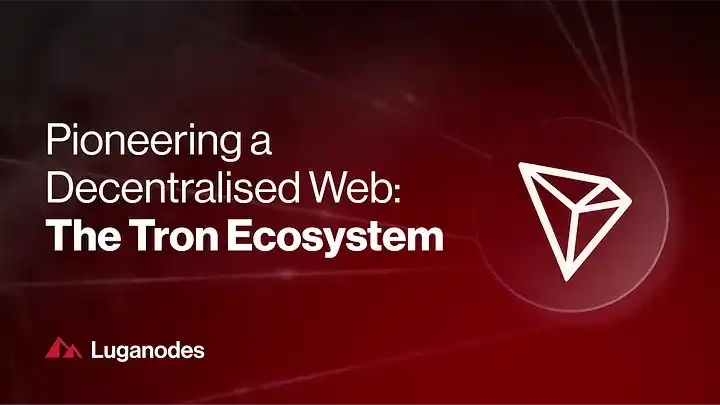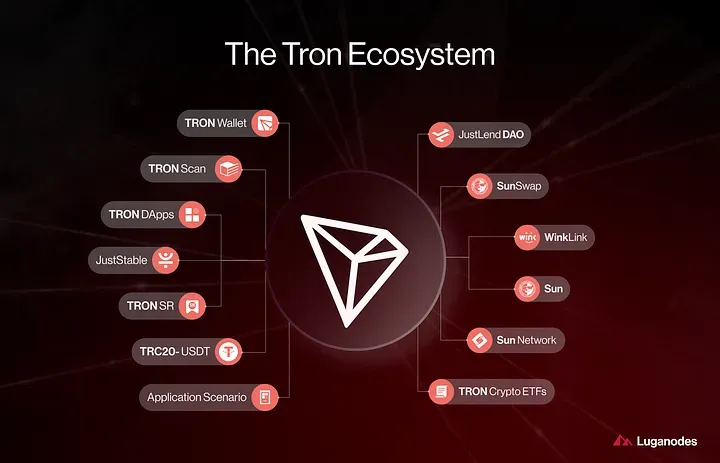6 min read
The Decentralised Web With TRON Ecosystem
A detailed dive into the TRON revolution

While TRON addresses very real concerns of high transaction fees and scalability — it is certainly not just about transactions. It is about transforming the very fabric of the internet. That’s the vision TRON’s founder, Justin Sun, had when he conjured up this digital wonderland. TRON isn’t just another chain; it’s on a mission to decentralise the web, giving power back to content creators and revolutionising how we interact online. The 172 million users are a testament to its revolution and make it the world’s fastest-growing public chain.
TRON was founded in 2017 as a digital token. It had humble beginnings as an ERC-20 token based on Ethereum but soon moved to its own blockchain in 2018. TRON also acquired BitTorrent, a very popular peer-to-peer file-sharing software. This further solidified TRON’s commitment to a decentralised web. If that wasn’t all — TRON put their money where their mouth is and dissolved the TRON Foundation, and instead opted to become a fully decentralised organisation in the form of the TRON DAO.
Speaking of revolutionary technology and revolutions in general — TRON created history by becoming the first major blockchain to partner with a sovereign nation to bolster its blockchain infrastructure. The Dominican Republic embraced the web3 future and as an emerging economy used it to its advantage. Certainly, surprising — but a welcome one!
TRON has its own TRON Virtual Machine (TVM) which is used to execute smart contracts. The TVM was initially an EVM (Ethereum Virtual Machine) fork and hence offers full compatibility, while also having improved upon it to create high-throughput, low-latency smart contract execution.
TRON has a 3-layer structure — based on the Google Protobuf system (a cross-platform data format used to serialise structured data). It consists of the core, storage and application layers. Each layer is specifically optimised for certain functionalities.
- The Core Layer — Deals with fundamental tasks, such as the Delegated Proof of Stake consensus algorithm. This layer also handles smart contracts and DApps. Solidity is the language of choice, as it offers great compatibility with Ethereum and is known to be efficient in DApp development.
- Storage Layer — A distributed data storage layer addressing the complex storage needs of the TRON blockchain.
- Application Layer — Provides easy interaction between developers and the TRON ecosystem.
As mentioned earlier, TRON uses a Delegated Proof of Stake consensus in which users vote for their delegates who have decision-making powers. The top 27 most-voted candidates become super representatives, responsible for producing blocks and packing transactions. They in turn receive voting rewards and block rewards. I must add that we are proud to be a part of the TRON super representative club!

We have some more tech terms that deserve a mention. Like the node types, each of which plays a varying role.
TRON nodes are integral components of the TRON blockchain network, responsible for maintaining the integrity, security, and functionality of the entire ecosystem. Nodes are instances of client software that adhere to the TRON protocol, enabling them to verify transactions and blocks, ensuring the accuracy of data across the network. There are different types of TRON nodes, each serving specific purposes:
- Fullnode: A Fullnode stores and synchronizes comprehensive blockchain data, continuously verifying all blocks and states within the network. It offers HTTP API and Grpc API interfaces for external queries, allowing developers to interact with the blockchain. Notably, Super Representatives, who are responsible for block generation and transaction packaging, operate Fullnodes.
- Lite Fullnode: The Lite Fullnode runs the same codebase as the Fullnode but starts based on a state data snapshot. This snapshot includes account state data and historical data from the latest 65536 blocks, making it significantly smaller than the entire Fullnode data. As a result, Lite Fullnodes require less disk space and have faster startup times, making Lite Fullnodes a suitable choice for developers who primarily need block synchronization, transaction processing, and broadcasting, or those who require post-startup block and transaction data queries.
At the heart of the dynamic TRON blockchain beats TRX, or Tronix, a versatile and essential cryptocurrency that powers the entire ecosystem. As the native digital currency, TRX fuels a wide spectrum of operations, from swift and secure peer-to-peer transactions to the seamless execution of smart contracts that power DApps. The unique structure of the TRON ecosystem has perpetually empowered the growth of content creators on its platforms. TRON enables a creator to receive payments for sharing content while maintaining control of their work. The meagre transaction fees just add to the benefits. Also, compared to other larger chains, TRON offers a much higher transaction rate at 2,000 transactions per second (which can now be increased when needed).
Beyond its functional utility, TRX also holds a democratic essence, allowing holders to participate in network governance, reflecting the ethos of decentralisation.
We have been through the wiring, the lifeblood and its history — now we shall look at a few more things that bring value to TRON.
Ecosystem — Much like the rest of the tech world, companies vie to create an ecosystem that offers an all-round solution to the user. And TRON has done that very well using its Wallet, Explorer, Stablecoins, SunSwap exchange and other similar projects.

Project Atlas — BitTorrent is a P2P file-sharing software, which has used reward systems to encourage users to share files for longer. Torrents have long championed decentralisation, aiming to shape an internet landscape where users wield control for a more equitable online experience. If that rings a bell, it’s no surprise that with its acquisition, TRON wants to fuse the two realms. Replacing rewards with tokens and bringing a new world of file sharing.
Partnerships — Collaborations are what make the tech world tick. More than a quarter of all phones sold are Samsung, and these phones are now supporting TRON standards and offer built-in blockchain wallets for TRX transactions. Poloniex — one of the leading digital asset trading platforms, Opera — a veteran web browser, APENFT — an NFT trading platform, Swisscom Blockchain and other such platforms have endorsed TRON.
We as an organisation and super representative very strongly believe in TRON’s vision of democratising the web. With its rapid growth and pioneering partnerships, TRON is breaking boundaries and ushering in a new era of real-world integration. Its commitment to content creators and user empowerment underscores its ethos, while its TRX cryptocurrency powers transactions and embodies the principles of decentralisation. Through initiatives like Project Atlas, TRON continues to reshape industries. As technology and empowerment intertwine, TRON is scripting a decentralised future where possibilities are boundless, inviting us all to be part of this transformative journey.
If you hold the TRX token, you can enhance your portfolio by staking to earn rewards. Leverage Luganodes' institutional-grade infrastructure to stake your holdings and create a passive income. Staking with us ensures ease of use, support, and safety while you earn, and also contribute to the security of the Tron chain.
Learn how to stake TRX tokens using this guide. You can learn more about staking on our website, and feel free to contact us for any queries!
About Luganodes
Luganodes is a world-class, Swiss-operated, non-custodial blockchain infrastructure provider that has rapidly gained recognition in the industry for offering institutional-grade services. It was born out of the Lugano Plan B Program, an initiative driven by Tether and the City of Lugano. Luganodes maintains an exceptional 99.9% uptime with round-the-clock monitoring by SRE experts. With support for 45+ PoS networks, it ranks among the top validators on Polygon, Polkadot, Sui, and Tron. Luganodes prioritizes security and compliance, holding the distinction of being one of the first staking providers to adhere to all SOC 2 Type II, GDPR, and ISO 27001 standards as well as offering Chainproof insurance to institutional clients.
The information herein is for general informational purposes only and does not constitute legal, business, tax, professional, financial, or investment advice. No warranties are made regarding its accuracy, correctness, completeness, or reliability. Luganodes and its affiliates disclaim all liability for any losses or damages arising from reliance on this information. Luganodes is not obligated to update or amend any content. Use of this at your own risk. For any advice, please consult a qualified professional.